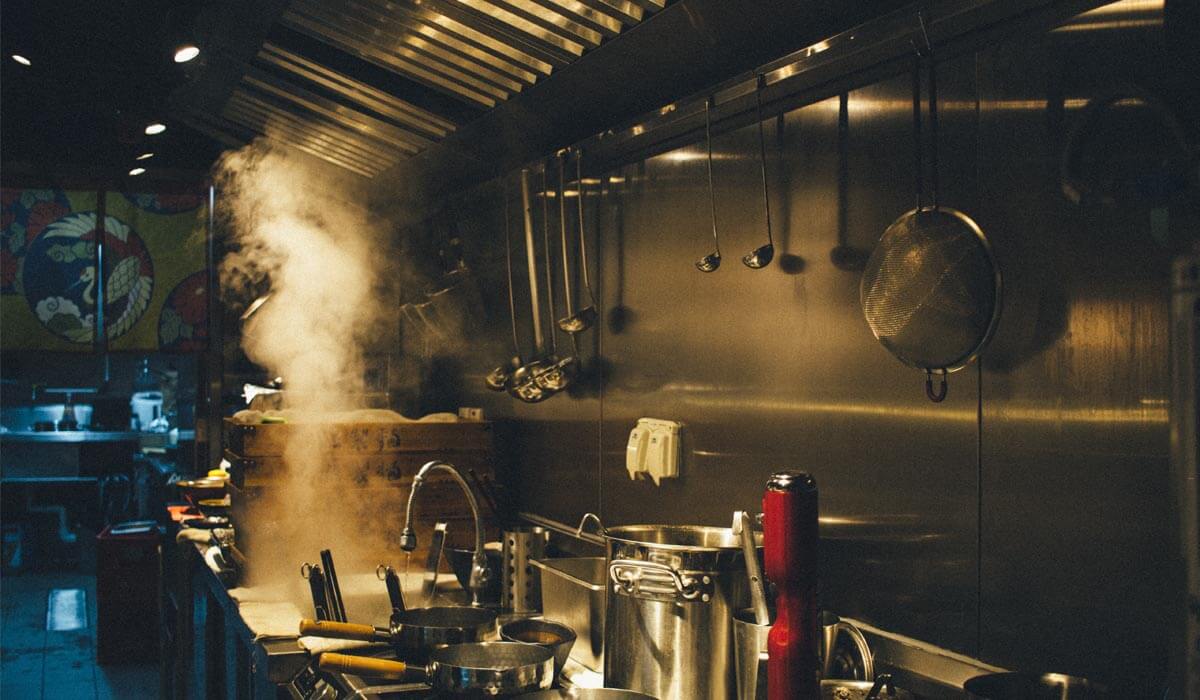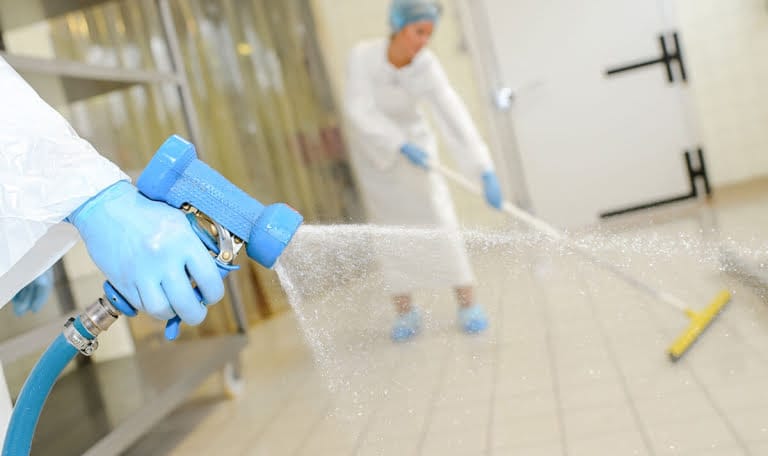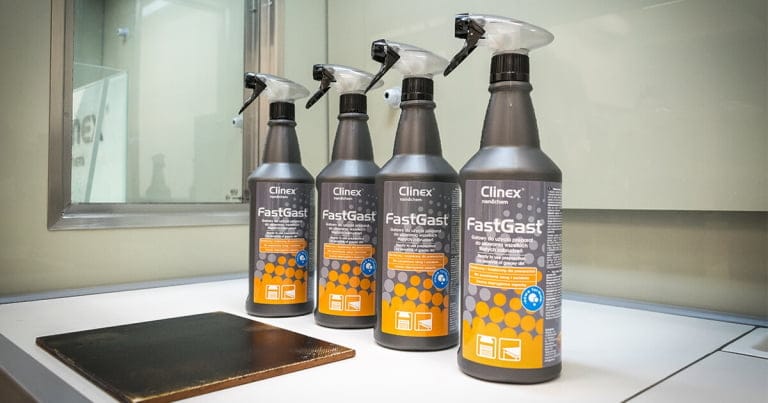The kitchen hood plays a very important role in every kitchen. Thanks to it, the air is clean and free from excess moisture. For the ventilation process to run smoothly, the hood must be washed regularly. Cleaning the hood is one of the most difficult cleaning steps in every kitchen. All because of the type of dirt that accumulates on the ventilation grilles. How to deal with it? How to clean the hood from grease?
How to clean the hood? From the article you will learn:
- How to clean a greasy hood in just a few minutes?
- Why is cleaning a kitchen hood important?
- What types of kitchen hoods do we use in gastronomy?
- What types of filters are there in kitchen hoods?
- What is worth knowing when having a hood with a carbon filter?
- How to clean a stainless steel hood?
Kitchen hood in gastronomy
Grease from the fumes and dust from the air create a layer of dirt that is difficult to remove. In catering facilities, hoods are particularly exposed to this type of contamination. Cooking food all day long on high heat causes the filter to become dirty quickly. If we neglect to wash the air filter regularly, a coating will form that is difficult to remove. As a consequence, the filter may become clogged, which will result in improper ventilation of the room. Therefore, it is worth remembering to clean the kitchen hood during daily cleaning.
Types of catering hoods
Catering hoods offer a wide range of products. They differ from hoods installed in home kitchens in terms of structure, size, but above all, functionality and durability. Hoods, or gastronomy hoods, are most often made of stainless steel, which is durable and easy to clean. Some models are additionally equipped with replaceable filters and fluorescent backlight.
There are wall and central models available on the market with various structures: sloping, box-shaped or trapezoidal. Industrial wall hoods are installed when the kitchen duct is located against the wall, and central ones when the ventilation is located in the center of the room. Hoods can also be divided according to the way they operate.
Types of hoods according to the method of operation:
- exhaust fans, the main purpose of which is to extract fat-containing vapors;
- supply and exhaust systems, which remove polluted air and supply fresh air, are divided into:
- induction – captures impurities to be filtered, air is blown towards the filters;
- compensating – they blow clean air from outside;
- compensating-inductive, combining the functions of the two above types.
There are three main types of supply and exhaust hoods:
- models with induction jet,
- models with compensation flow,
- models with induction and compensation flow.
In induction hoods, air is blown towards the filters (grease traps). In this solution, the flow of extracted air towards the exhaust ducts is intensified. In compensating hoods, air is blown into the room. Fresh air flows directly into the kitchen work area through the perforated front wall. Induction-compensating hoods combine both solutions.
The extractor hood is used when the kitchen hood can be connected to the ventilation duct. This solution makes it possible to filter all vapors and remove them outside. Kitchen hoods without ventilation use kitchen absorbers to filter the vapors floating above the kitchen.
What types of filters are used in hoods?
Various types of filters are used in kitchen hoods, among which there are three main types: anti-grease filters (grease absorbers), odor-absorbing filters and labyrinth filters.
The main task of grease filters is to trap fat. Most often, they are made of non-woven fabric or metal. Kitchen odor absorbers are mainly carbon filters. In solutions for gastronomy, labyrinth filters are also often found, which are made of properly formed stainless steel sheets. How do they work? The drawn air, reaching between subsequent layers of sheet metal, deposits water and fat particles on them. These are real grease traps – they capture fat droplets found in water vapor.
Hood with a carbon filter – what do you need to remember?
If we neglect the hood, the ventilation process may be disturbed, which has a negative impact on the health of kitchen workers. If we have a hood with a carbon filter, it should be replaced regularly (max. every 4 months). Each time the filter is replaced, it is necessary to thoroughly clean the hood. For this purpose, it is worth equipping yourself with professional cleaning products. Please remember that hoods equipped with a carbon filter are usually absorbers that are not connected to the ventilation duct. That’s why replacing the filter frequently is so important. However, you can use a carbon filter in hoods with a ventilation hood, which increases its efficiency by almost 20%.
How to clean a kitchen hood?
Most catering hoods are made of stainless steel. How to clean stainless steel? Of course, with appropriately adapted preparations. The Clinex brand offers a wide selection of professional cleaning products for catering outlets and more. Thanks to them, cleaning the stainless steel hood will be simple and extremely quick. Clinex Fast Gast will be perfect for this role. Available in a convenient spray bottle, it allows you to effectively dispense the finished preparation, reaching even hard-to-reach places. It has a strong degreasing effect, thanks to which it perfectly removes greasy and oily dirt. It is suitable for everyday cleaning in the kitchen and as a preparation for stubborn grease and dirt from the hood.
How to clean the hood from grease?
Before starting the cleaning process, disconnect the device from the power source. Then we remove the grille from the hood and take out the filter. Spray the preparation on the dirty surfaces and wait a while until the agent dissolves the grease and other dirt. Then we carefully wipe the residues with a microfiber cloth, taking care of all the nooks and crannies. Some hoods are equipped with replaceable filters, others require cleaning. The grille is the most dirty surface of the hood, and cleaning it usually takes the most time. Therefore, it is a good idea to use the Clinex GreaseOff preparation, which will perfectly cope with heavy greasy dirt. It is a reliable agent with excellent degreasing properties.
How to clean a greasy hood in just a few minutes? Is it possible?
Anyone who has ever had to deal with a heavily dirty hood knows that cleaning it is not an easy task. Dirt collected on the grille is particularly stubborn. Can it be cleaned in just a few minutes? If you do not have time to bathe the grate in a solution of hot water and dish soap for an hour, use Clinex GreaseOff. Just spray the grate generously with the agent and leave for a few minutes. During this time, its active ingredients will completely dissolve grease and dirt, which will then become easy to remove. It also copes perfectly with oil stains and can be successfully used to clean engines. In the case of a heavily dirty hood, it is worth using both preparations, with Clinex GreaseOff as a cleaning agent.
What are gastronomy hoods made of?
Kitchen hoods can be made of various types of materials. Each material requires a different cleaning technique and appropriate cleaning agents. In the catering industry, the most desirable material is, of course, stainless steel. Inox, i.e. acid-resistant steel used in the production of catering equipment, may have different varieties. These varieties have their markings depending on the chromium and nickel content. How to clean stainless steel? When selecting cleaning products, it is worth choosing safe and proven products. How to clean chrome and how to clean aluminum? Both Clinex GreaseOff and Clinex Fast Gast will be a safe cleaning agent here.
Cleaning the hood casing – how to clean a stainless steel hood?
How to clean stainless steel? Stainless steel is relatively easy to keep clean. However, improper cleaning may leave unsightly streaks. So how to clean a stainless steel hood? Using Clinex products, cleaning this type of surface is a piece of cake! Clinex Fast Gast has excellent emulsifying properties, making cleaning stainless steel exceptionally pleasant and easy. Just spray the surface with the preparation and after a few moments wipe it with a soft microfiber cloth. Leaving the surface wet can result in streaks, so stainless steel should always be wiped dry. Thorough scrubbing with a dry cloth will make the steel shine and the hood will shine like a new one!






